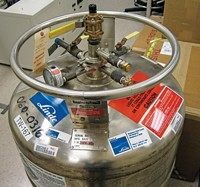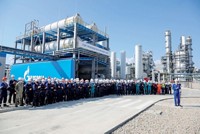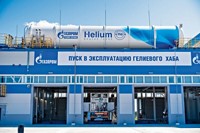Advertisement
Grab your lab coat. Let's get started
Welcome!
Welcome!
Create an account below to get 6 C&EN articles per month, receive newsletters and more - all free.
It seems this is your first time logging in online. Please enter the following information to continue.
As an ACS member you automatically get access to this site. All we need is few more details to create your reading experience.
Not you? Sign in with a different account.
Not you? Sign in with a different account.
ERROR 1
ERROR 1
ERROR 2
ERROR 2
ERROR 2
ERROR 2
ERROR 2
Password and Confirm password must match.
If you have an ACS member number, please enter it here so we can link this account to your membership. (optional)
ERROR 2
ACS values your privacy. By submitting your information, you are gaining access to C&EN and subscribing to our weekly newsletter. We use the information you provide to make your reading experience better, and we will never sell your data to third party members.
Business
Helium Supply Gets A Lift
Industrial Gases: New plant in Qatar will ease shortages for scientific instrument users
by Marc S. Reisch
July 15, 2013
| A version of this story appeared in
Volume 91, Issue 28

The start-up of a big new helium plant in Qatar should go a long way to ease shortages of the lighter-than-air chilling gas, which is essential to the operation of many scientific instruments and to the manufacture of fiber-optic cables and semiconductors.
The plant, in Qatar’s Las Raffan Industrial City, is the world’s largest helium liquefier, with a production capacity of more than 1.3 billion cu ft per year, according to Air Liquide, which built the purification and chilling equipment. It is operated by Qatar’s RasGas, which separates the helium from natural gas that is drawn from the country’s North Field deposits.
The new unit, with annual capacity of 2.1 billion cu ft., makes Qatar the world’s second-largest source of helium. The U.S. cranked out nearly 4.9 billion cu ft of helium last year, of which more than 60% was exported, according to the U.S. Geological Survey.
Air Liquide says the start-up marks the next step toward stability in the global helium market, which has been plagued by production glitches and falling supply from traditional sources. Air Liquide has a contract to buy and distribute half of the new Qatari helium. Germany’s Linde and Japan’s Iwatani will buy the remainder of the output.
U.S. users welcome the additional supply, but they say helium prices remain too high. “Helium is still $13 per L for us,” says Martha Morton, director of research instrumentation at the University of Nebraska, Lincoln. Last year prices were as high as $22 per L for some users, up from about $5 per L a few years earlier.
Morton has already heard from suppliers that prices will rise in 2014. That’s when she plans to refill a repaired 600-MHz nuclear magnetic resonance instrument that was damaged last year when she couldn’t get the helium needed to keep it operating.
Just how much of an increase Morton will have to pay hinges on the potential shutdown in October of Cliffside Field, a U.S. government reserve in Texas that accounted for one-third of the world’s helium output last year. Congress is now considering legislation to keep the field operating for a few more years until reserves run out.





Join the conversation
Contact the reporter
Submit a Letter to the Editor for publication
Engage with us on Twitter